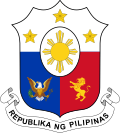| | ||||||||||||||||||||
| ||||||||||||||||||||
| ||||||||||||||||||||
 Election results. Party with the highest number of votes of the gubernatorial election in each province is shaded its party's color. For assembly results, each circle represents a seat, shaded by the party that won that seat. | ||||||||||||||||||||
| ||||||||||||||||||||
 |
|---|
The 2016 general election in the Autonomous Region in Muslim Mindanao (ARMM) was held on May 9, 2016. This was the second ARMM election that was synchronized with the general election in the Philippines and the last general election in the ARMM.
Contents
The governor and vice governor are elected via first past the post system; they are elected separately and may come from different parties. Elections for the regional assembly are via plurality-at-large voting, with each assembly district (coextensive with legislative districts as used in House of Representatives elections) having three seats. A voter can vote for up to the three candidates, with the candidates with the three highest total number of votes being elected.
This was the last general election in the ARMM. The elections in May 2019 were superseded by the approval of the new autonomous region, the Bangsamoro, via a plebiscite in January and February 2019. ARMM itself dissolved on February 26, 2019 when the Bangsamoro Transition Authority took over from the ARMM. The winners of the 2016 election were given the option to opt in to join the Bangsamoro Transition Authority Parliament until their terms expired on June 30. All but one, Regional Governor Mujiv Hataman, opted in.
The first general election in the Bangsamoro shall be on October 13, 2025; after it was scheduled from 2022. However the Supreme Court declared the two districting laws as unconstitutional postponing the election yet again for the third time and is expected to be held no later than March 31, 2026.


